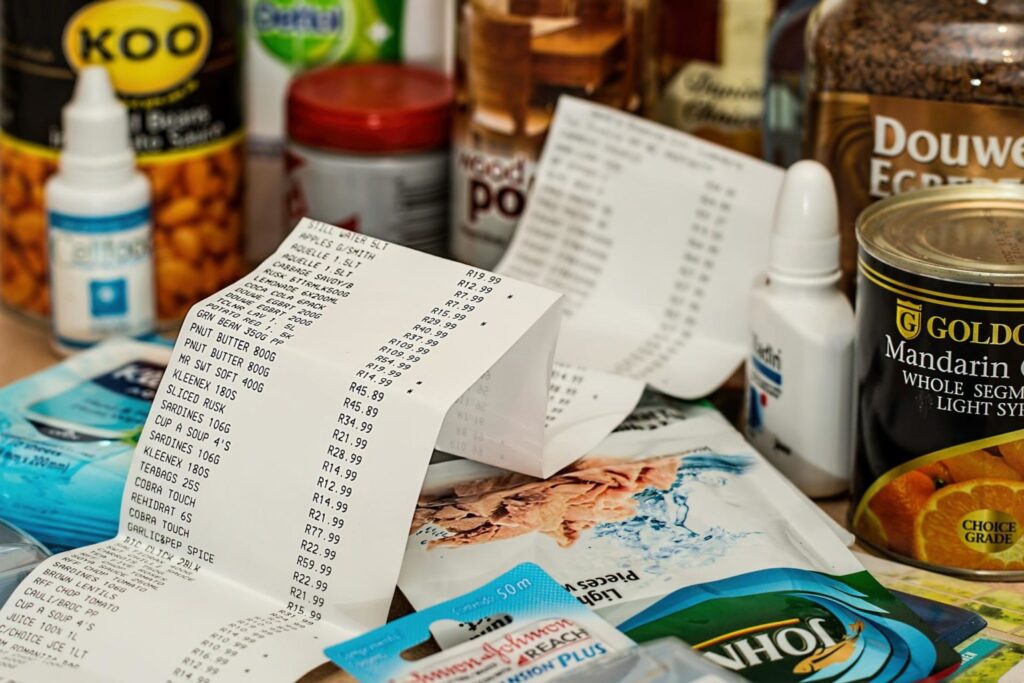
It’s no secret that inflation is causing prices on everything to soar. Inflation is rampant, and there’s no end in sight. Grocery prices are constantly rising, and many families are having a difficult time making ends meet and buy food to feed the family.
Families are finding themselves in a pickle – just trying to put food on the table has become nearly impossible for so many people. It shouldn’t be this way, but it is, and many people now find themselves trying to find ways to be frugal and learn how to save money on groceries.
Saving money on groceries is not easy, especially with inflation and the rising high prices on just about everything. But there are some tips and tricks that can help you save money on your grocery bill every week.

Follow these frugal money saving tips to help stretch your money and improve your grocery budget.
Note: Grocery buying and/or food buying includes things like dog food, cat food, paper towels, TP, baby wipes, disinfectant wipes, shampoo, bath soap, dish soap, detergent, etc… basic things most families need.
- The first step to being frugal and save money on groceries is to always make a list prior to going shopping. A list helps you stay on budget and prevents the impulse purchases at the store. Unless you find super great markdowns, stick to the list.
- While marking out your grocery shopping list, check for weekly sales for any stores you will be shopping at. Weekly sales ads can often be found in your mailbox, in your local paper, and online at the store’s website. Taking advantage of weekly sales can help you save money on groceries.
- A great frugal tip is to pair coupons with any sales. This will give you a greater discount and savings. Coupons are usually in Sunday papers, plus you can find printable coupons at Coupons.com, where you can print each coupon twice. If your local store doubles or triples coupons on certain days, try to shop on those days when you have coupons to use to help maximize your savings.
- Buy food you have to cook, rather than food that’s already prepared. In general, the more prepared something is, the more it costs. While convenience foods are nice, they’re usually costly. You can get the most stretch out of your money when you buy foods you have to prepare.
- Learn to know the difference in what you want verses what you need. Ladies, a lot of you like to wear makeup. You want it. But here’s the cold hard truth – you don’t need it. If you’re having a difficult time buying food, it’s time to stop spending money on makeup. A lot of you like to eat out. You want to eat out. But you don’t need to eat out. If you’re having a hard time buying food, it’s time to stop spending money on eating out. You get the idea.
- Prioritize your grocery buying list (see #1 above). Once you get a list made, decide what you need the most and write the list in order of what you need the most, putting the most needed at the top and moving downward. When you get to the end, it should be what you need the least. Making a list in this manner will assure that you should be able to get the grocery items you need most of all first.
- Young moms with children in diapers, you can save a lot of money when you use cloth diapers for your baby. Yes, I know it’s not as convenient as disposable diapers. But when you’re having a hard time putting food on the table, it’s time to do what all of us before you did – use cloth diapers. Save the disposable diapers for night time or going somewhere. When you’re at home, save yourself a lot of money by using cloth diapers. Use the money you save from not buying expensive disposable diapers to buy food and groceries.
- A lot of stores have markdowns on food items that are about to come to the best sell by date or best used by date. When you see meat marked down like this, it can be frozen and be food for anywhere from a month more to four or five months more. If the amount of meat is too much for one meal, divide it up before freezing it. Put it in plastic freezer containers, zipper freezer bags, wrap well in foil, or wrap in freezer paper. You can use some masking tape or freezer tape and mark the date if you want to.
- Cut out most soft drinks and junk type foods. Buy real food, healthy food when possible. Leave the sugary soft drinks, chips, donuts, cakes, pies, cookies, candy, etc. Save those kinds of things for special occasions like birthdays and such. When money is tight, spending it on junk food simply isn’t wise.
- If you have space, consider growing your own veggies. Some veggies are fairly easy to grow. Some of the most popular are tomatoes, peppers, cucumbers, carrots, squash, etc. If you do opt to grow you own veggies, be sure to buy only heirloom seeds.
- Try to stock up on some basic inexpensive food items so that you always have something to fall back on if times get super tough and you can’t afford to buy food for a pay period. These basic foods include food items such as:
- brown rice
- dry beans
- oatmeal
- grits
- ramen noodles
- pasta
- pancake mix
- tater tots
- corn meal
- flour
- applesauce
- tuna
- fresh chicken
- carrots
- can veggies (peas, beans, carrots, potatoes, etc.)
- frozen veggies (broccoli, squash, etc.)
- eggs
- dry powered milk
Saving money on groceries isn’t easy, that’s a given. It might mean totally changing the way you normally shop and what you normally buy. It means stop eating out, to cook and eat at home. It means getting the most out of your dollar, stretching it as best as you can, to get the most food in today’s high inflation world.
But the good news is that you can do it! It’ll take a little practice, to be sure. Don’t give up, just cut out things you want but don’t actually need and concentrate on what you truly need.

